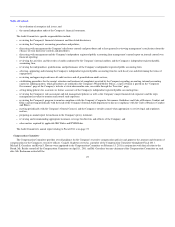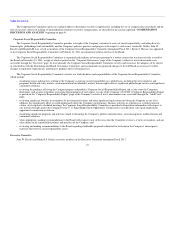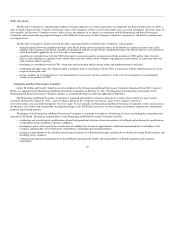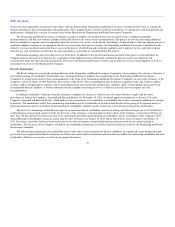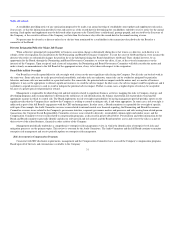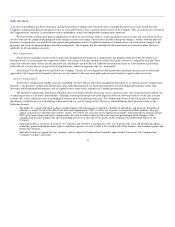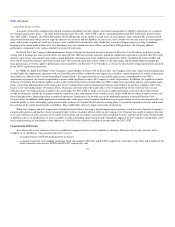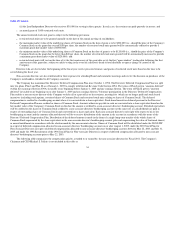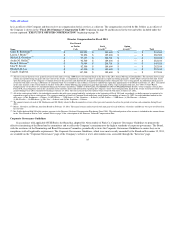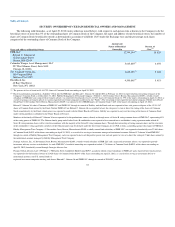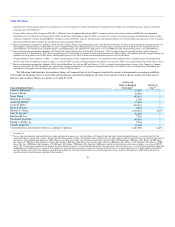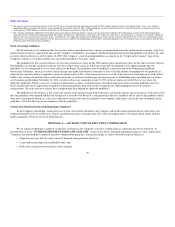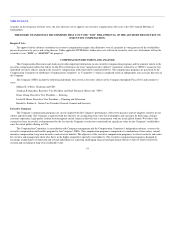Abercrombie & Fitch 2012 Annual Report Download - page 34
Download and view the complete annual report
Please find page 34 of the 2012 Abercrombie & Fitch annual report below. You can navigate through the pages in the report by either clicking on the pages listed below, or by using the keyword search tool below to find specific information within the annual report.
Table of Contents
A stockholder providing notice of any nomination proposed to be made at an annual meeting of stockholders must update and supplement such notice,
if necessary, so that the information provided is true and correct as of the record date for determining the stockholders entitled to receive notice for the annual
meeting. Such update and supplement must be delivered either in person or by United States certified mail, postage prepaid, and received by the Secretary of
the Company, at the executive offices of the Company, not later than five business days after the record date for the annual meeting at issue.
No person may be elected as a director unless he or she has been nominated by a stockholder in the manner just described or by the Board or a
committee of the Board.
Director Resignation Policy for Major Job Change
When a director's principal job responsibility or business association changes substantially during his or her tenure as a director, such director is to
submit a letter of resignation for consideration by the Nominating and Board Governance Committee. It is not the sense of the Board that in every instance the
director who retires or substantially changes the position he or she held upon joining the Board should leave the Board. There should, however, be an
opportunity for the Board, through the Nominating and Board Governance Committee, to review the effect, if any, of the revised circumstances on the
interests of the Company. Upon receipt of such a letter of resignation, the Nominating and Board Governance Committee will duly consider the matter and
make a timely recommendation to the full Board of the appropriate action, if any, to be taken with respect to the resignation.
Board Role in Risk Oversight
Our Board has overall responsibility for risk oversight with a focus on the most significant risks facing the Company. Not all risks can be dealt with in
the same way. Some risks may be easily perceived and controllable, and other risks are unknown; some risks can be avoided or mitigated by particular
behavior, and some risks are unavoidable as a practical matter. For some risks, the potential adverse impact would be minor, and, as a matter of business
judgment, it may not be appropriate to allocate significant resources to avoid the adverse impact. In other cases, the adverse impact could be significant, and it
is prudent to expend resources to seek to avoid or mitigate the potential adverse impact. Further, in some cases, a higher degree of risk may be acceptable
because of a greater perceived potential for reward.
Management is responsible for identifying risk and risk controls related to significant business activities; mapping the risks to Company strategy; and
developing programs and recommendations to determine the sufficiency of risk identification, the balance of potential risk to potential reward and the
appropriate manner in which to control risk. The Board implements its risk oversight responsibilities by having management provide periodic reports on the
significant risks that the Company faces and how the Company is seeking to control or mitigate risk, if and when appropriate. In some cases, risk oversight is
addressed as part of the full Board's engagement with the CEO and management. In other cases, a Board committee is responsible for oversight of specific
risk topics. For example, the Audit Committee oversees issues related to internal control over financial reporting; the Nominating and Board Governance
Committee oversees issues related to the Company's governance structure, corporate governance matters and processes and risks arising from related person
transactions; the Corporate Social Responsibility Committee oversees issues related to diversity, sustainability, human rights and similar issues; and the
Compensation Committee oversees risks related to compensation programs, as discussed in greater detail below. Presentations and other information for the
Board and Board committees generally identify and discuss relevant risk and risk control; and the Board members assess and oversee the risks as a part of
their review of the related business, financial or other activity of the Company.
Management periodically undertakes a comprehensive enterprise risk management review, in which the identification of enterprise level risks and
mitigation processes are the primary topics. This review is overseen by the Audit Committee. The Audit Committee and the full Board continue to monitor
enterprise risk management and receive periodic updates on enterprise risk management.
Risk Assessment in Compensation Programs
Consistent with SEC disclosure requirements, management and the Compensation Committee have assessed the Company's compensation programs.
Based upon all of the facts and circumstances available to the Company
31






